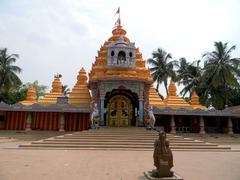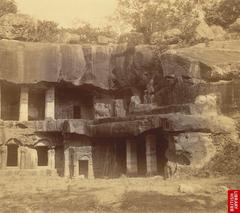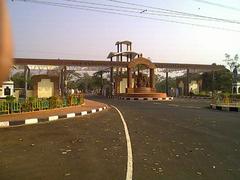Nakulesvara Siva Temple: Complete Visitor Guide to Bhubaneswar’s Historic Gem
Date: 14/06/2025
Introduction
Nestled in the vibrant Old Town of Bhubaneswar, Odisha, the Nakulesvara Siva Temple stands as a testament to India’s spiritual and architectural legacy. Built in the 7th century CE, it is among the earliest surviving examples of Kalinga temple architecture and remains an active center of Shaivite worship. The temple’s distinctive Rekha Deula style, intricate stone carvings, and mythological symbolism have drawn pilgrims, history enthusiasts, and tourists for generations. As a pivotal monument in the “City of Temples,” Nakulesvara Siva Temple not only reflects the city’s spiritual traditions but also its artistic heritage, making it a must-visit for anyone exploring Bhubaneswar’s historical sites.
This comprehensive guide covers Nakulesvara Siva Temple’s history, architecture, visiting hours, ticketing, accessibility, travel tips, and nearby attractions. Whether your interest lies in spirituality, history, or culture, the temple offers an enriching experience. For detailed planning, refer to official resources such as the ASI Odisha and Odisha Tourism websites.
Table of Contents
- Historical Evolution of Nakulesvara Siva Temple
- Architectural Highlights
- Visiting Hours, Tickets & Accessibility
- Travel Tips & Responsible Tourism
- Festivals and Rituals
- Nearby Attractions
- Frequently Asked Questions (FAQs)
- Preservation & Modern Relevance
- Conclusion
- Sources
Historical Evolution of Nakulesvara Siva Temple
Early Origins
Nakulesvara Siva Temple, constructed under the Shailodbhava dynasty (circa 650–700 CE), is one of the first stone temples in Bhubaneswar. Its creation marked the beginning of the Rekha Deula style, a defining feature of Kalinga architecture. Along with Laxamanesvara and Bharatesvara temples, it represents the city’s early temple-building era, characterized by modest structures and locally sourced sandstone (ASI Odisha).
Religious and Cultural Importance
Dedicated to Lord Shiva as Tribhubaneswar, the temple’s sanctum houses a self-manifested (Swayambhu) lingam, revered as Harihara—symbolizing unity between Shaivism and Vaishnavism. Bhubaneswar, or Ekamra Kshetra, has long been a center of Shaivite worship, and Nakulesvara’s continued rituals and festivals uphold this legacy (FabHotels).
Historical Developments
Throughout centuries, the temple has been maintained by various patrons, with its original structure largely intact. While later temples like Mukteswara and Lingaraja introduced more elaborate designs, Nakulesvara remains a crucial reference for scholars studying the evolution of Odishan temple architecture (Times of India).
Architectural Highlights
Design & Structure
Nakulesvara Siva Temple exemplifies early Kalinga Rekha Deula architecture. Key features include:
- Vimana (Sanctum Tower): A curvilinear spire rising above the sanctum, topped by an amalaka and kalasha.
- Layout: Unicameral plan without a Jagamohana (assembly hall), focusing attention on the sanctum.
- Ornamentation: Exteriors are adorned with intricate carvings of Shiva, Saptamatrikas, mythological scenes, and motifs such as Ravananugraha and Nataraja.
- Building Materials: Constructed with locally sourced sandstone using traditional dry masonry techniques.
The temple’s eastward orientation aligns with ritual practices, and the design follows Shilpa Shastra and Vastu Shastra principles for sacred geometry and proportions (Vajiram & Ravi).
Visiting Hours, Tickets & Accessibility
Opening Hours
- Daily: 6:00 AM – 8:00 PM
Peak hours are early morning and late afternoon for a peaceful experience.
Entry Fees
- Free entry for all visitors. Donations are welcome for temple upkeep.
Location & How to Reach
- Address: Old Town, Bhubaneswar, Odisha, near the southern outskirts and close to Manikarnika tank.
- By Air: Biju Patnaik International Airport (~6 km)
- By Train: Bhubaneswar Railway Station (~5 km)
- By Road: Taxis, auto-rickshaws, and app-based rides are available throughout the city.
Accessibility
- The temple is accessible to most visitors, with ramps at the entrance. However, uneven stone pathways and steps may challenge those with limited mobility. Contact the temple trust ahead for assistance if needed.
Travel Tips & Responsible Tourism
- Wear modest clothing (shoulders and knees covered).
- Remove footwear before entering temple premises; shoe racks are provided.
- Photography is allowed in outer areas but restricted inside the sanctum. Always follow signage.
- Carry water in reusable bottles; drinking water and restroom facilities are limited.
- Arrive early during festival days to avoid crowds.
- Support local vendors by purchasing offerings and souvenirs.
- Dispose of waste responsibly and avoid single-use plastics.
Festivals and Rituals
Major Festivals
- Maha Shivaratri: The grandest festival, with night-long vigils, chanting, and rituals.
- Pradosha, Kartika Purnima, Shravan Month: Regularly celebrated with special pujas and community gatherings.
Ritual Practices
Daily worship includes abhisheka (ritual bathing of the lingam), offering bilva leaves, flowers, and incense. Devotees may participate in rituals; offerings are available from nearby vendors.
Nearby Attractions
- Lingaraja Temple: The largest and most iconic temple in Bhubaneswar.
- Mukteswara Temple: Renowned for its exquisite torana (archway).
- Rajarani Temple: Famed for sculptural beauty.
- Manikarnika Tank: Sacred water body adjacent to Nakulesvara.
- Odisha State Museum & Ekamra Kanan Botanical Gardens: For broader cultural and natural exploration.
Frequently Asked Questions (FAQs)
Q: What are the Nakulesvara Siva Temple visiting hours?
A: 6:00 AM to 8:00 PM daily.
Q: Is there an entry fee?
A: No, entry is free. Donations are welcome.
Q: Are guided tours available?
A: Yes, local guides and audio tours (including the Audiala app) are available.
Q: Is the temple accessible for differently-abled visitors?
A: Ramps are provided, but some areas have uneven flooring and steps.
Q: Can non-Hindus enter the temple?
A: Non-Hindus are welcome in most areas except the innermost sanctum.
Q: Is photography allowed?
A: Permitted in outer precincts; restricted in the sanctum. Always follow posted guidelines.
Preservation & Modern Relevance
Nakulesvara Siva Temple is protected as a monument of national importance by the Archaeological Survey of India. Conservation efforts include structural stabilization, restoration, and community engagement to ensure the temple’s legacy endures. The temple remains a vibrant center for religious activity, cultural festivals, and scholarly study, contributing to Bhubaneswar’s status as a living heritage city (ASI Odisha).
Conclusion
Nakulesvara Siva Temple offers a rare journey into Odisha’s spiritual and artistic heritage. Whether you are exploring its ancient carvings, participating in rituals, or enjoying the tranquil atmosphere, the temple embodies the living traditions of Bhubaneswar’s temple city. Plan your visit with this guide, embrace responsible tourism, and consider extending your exploration to nearby historic sites for a comprehensive experience.
For the latest updates, festival information, and immersive guided experiences, download the Audiala app and follow official tourism platforms. Step into Nakulesvara Siva Temple and discover the timeless confluence of devotion, artistry, and history.
Sources and Further Reading
- ASI Odisha
- Odisha Tourism
- FabHotels
- Tripcrafters
- Times of India
- Stamped Moments
- HelloTravel
- Tusk Travel
- Wikipedia
- NativePlanet
- Vajiram & Ravi
- IJFMR
Optimize your visit and support sustainable tourism. Download the Audiala app for guided audio tours and follow us on social media for travel inspiration and cultural updates.








